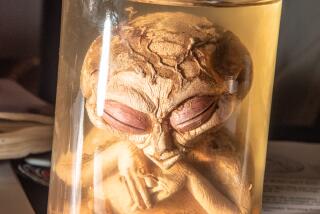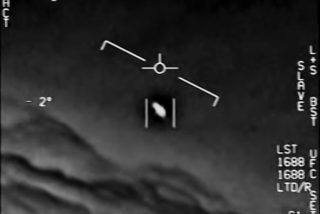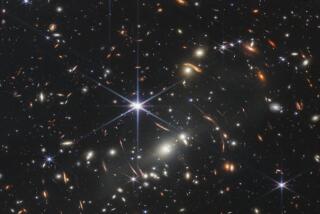THE WHOLE SHEBANG: A State-of-the-Universe(s) Report.<i> By Timothy Ferris</i> .<i> Simon & Schuster: 393 pp., $25</i>
- Share via
In this cleverly named book, veteran science writer Timothy Ferris takes us on a tour of the horizons of current thinking about the origin of the universe and the fundamental nature of matter. His purpose in “The Whole Shebang,” at least in part, is to explain why scientists today often argue that we cannot understand the universe (the largest thing we can think of), unless we understand the nature of subatomic particles (the smallest things we can think of). In Ferris’ words, if we want to “find our place, we must know the place, cellar to ceiling, from taproots to the stars, the whole shebang.”
He begins with the story of how human thought about the cosmos evolved over the millenniums, moving from the Greek astronomers to the Big Bang to satellite observatories. This is a familiar story, but it is well told, filled with personal vignettes of the men and women involved in the discoveries and with vivid analogies that show the almost miraculous nature of the scientific concepts involved.
For example, in discussing the expansion of the universe, Ferris considers the work of cosmologists who argue that the universe seems to have almost (and perhaps exactly) enough mass, or “critical density,” to bring its current expansion to a halt. He equates the difficulty scientists have in finding this density with the prospect of finding one of those unusual natural formations, a balancing rock in an Arizona mountain range, at the exact moment when it’s about to tip over. Ferris writes: “Balancing rocks are rare, but we’re more likely to encounter one than to happen upon the scene just as the rock has started to fall. [In the language of cosmologists] . . . an almost critical density is a rock just starting to fall.”
Throughout the early part of the book, Ferris presents historical developments with an eye toward illuminating current controversies among cosmologists. One argument that has been going on for more than a decade, for example, concerns the age of the universe. The basic technique astronomers use to estimate this number involves measuring the current rate of expansion and then “running the film backward” to see when the expansion started. Because measuring the expansion rate involves measuring the distance and rate of recession between us and the farthest galaxies--measurements that push the envelope of what is technically possible--there has been a minor donnybrook going on between those who think the universe is about 15 billion years old and those who argue for an age of about half that figure.
One problem is that if the “young universe” people win, we will have the seemingly paradoxical situation of the universe being younger than the oldest stars. Actually, this isn’t so strange. When Edwin Hubble first measured the expansion rate in the 1920s, the estimated age of the universe was actually younger than the Earth. How this all got resolved, and where things stand now, is admirably dealt with in Ferris’ discussion. I learned something new from these chapters, even though I follow this field fairly closely.
The book also plunges into the strange and wonderful world of modern cosmology, with its arcane language of general relativity and superstring theory. Once again, Ferris gets us through the difficult stuff by skillful use of analogy and anecdote. A black hole, he says, is “like a prisoner of war reciting only name, rank, and serial number. . . . It will tell you nothing but its mass, its rotation, and its electrical charge.”
He goes on to deal, one by one, with the central notions of modern cosmology, including dark matter (the most abundant form of material in existence) and superstring theory (our best candidate so far for a “theory of everything,” which says that the substance of space is organized into very tiny strings of subatomic particles). These chapters survey the latest ideas about the early stages of the universe. They are full of interesting bits of history and personality. In describing the work that led to the realization that most matter is made from quarks, for example, Ferris mentions that the early theories were (for technical reasons) referred to by physicists as the “eightfold way.” He then goes on to explain why they were called that and he even refers to the first sermon of the Buddha when he talked about the Eightfold Way as “right understanding, thought, speech, action, livelihood, effort, mindfulness, and concentration.”
Unfortunately, Ferris also strains a little in order to set the stage for his final chapters. He grossly understates the role of Alan Guth of MIT in developing the so-called inflationary model of the universe, which refers to the idea that the universe went through an extremely rapid expansion early in its lifetime, and in making inflation a part of today’s standard cosmology. Ferris underplays Guth’s role, I think, because he wants to use theories developed by other cosmologists as a take-off point for his later speculations, but as someone who has followed the “inflation wars” closely, I believe Ferris’ account to be something of a distortion of the historical record.
And there are also some misstatements. Ferris refers, for example, to the fact that there is almost no antimatter in the universe, despite the fact that the laws of elementary particles treat matter and antimatter evenhandedly as a “frozen accident” in the evolution of the universe. In fact, it was the realization in the early 1980s that the laws of nature are not quite evenhanded in their treatment of these two types of matter and that this lack of symmetry could explain the absence of antimatter in the universe that began the whole current boom in the study of the early universe. Far from being a frozen accident, the absence of antimatter is an absolutely predictable consequence of the basic laws of physics as they are revealed in the laboratory.
Once he has presented this background, Ferris moves into the much more speculative realm of the origin of the universe and the nature of what has come to be called “quantum weirdness,” two subjects that modern cosmologists realize are intimately related. He discusses the way in which the two can come together, at least in some theories, to produce a world of multiple universes, a development that explains the “universe(s)” in the book’s subtitle. When the universe was very young (and I do mean very young, we’re talking about a tiny fraction of its first second of life here), it was so small that the laws that govern subatomic particles could be applied to it as a whole. This means that in its early stages, the universe can be pictured as having a fuzzy, foamy quality that is not apparent in its current expanded state. From this beginning, some cosmologists (Ferris focuses on the work of Andrei Linde) have concocted scenarios in which all manner of strange beasts, like multiple universes, abound.
Ferris goes through the familiar litany of weird quantum mechanical concepts, wave particle duality, the hypothesis known as “Schrodinger’s cat” and Einstein’s objections to seeming violations of causality in certain experiments. He also goes at some length into some interpretations of quantum mechanics that can most generously be described as “out of the mainstream.”
The problem of “understanding” quantum mechanics seems to be one of those intractable intellectual difficulties that refuses to go away and refuses to be resolved. Ferris quotes the late Richard Feynman on this subject: “[quantum mechanics] . . . describes nature as absurd from the point of view of common sense. And it agrees fully with experiment. So I hope you can accept nature as she is--absurd.”
For what it’s worth, like everyone else who has tried to think about the origins of the universe, I, too, have real difficulties coming to any sort of intuitive understanding of life in the subatomic world. It’s a world that seems full of paradoxes; it just doesn’t conform to our expectations about how the world should be and therefore just doesn’t “make sense.” We can’t picture what it’s like, and that means that we can’t “see” what goes on. When we impose the familiar concepts of our everyday world--particles, waves, measurements and so on--we encounter a bewildering assortment of paradoxical situations.
I’ve come to terms with the quantum world by remembering that my notion of “common sense” is built on a lifetime’s experience with ordinary-size objects. Indeed, you could argue that the human brain evolved explicitly to make sense of that particular world. I’ve never experienced an electron directly and neither have any of the philosophers who discourse on this subject. If I just can’t get my mind around some quantum concepts, my conclusion is that we have, for the first time, encountered a realm of nature whose behavior just doesn’t fit the neural connections in our brains. Given that we are embarked on a massive exploration of the cosmos, from the farthest quasar to the tiniest quark, I suppose it was inevitable that we would encounter this sort of barrier sooner or later. So be it.
This sort of fatalism is not acceptable to some thinkers who continue to believe that nature could not be so cruel as to produce a universe we can’t visualize. It is this somewhat fringy element that Ferris has chosen to highlight in his book. His choice is unfortunate because that element is somewhat out of the mainstream of the scientific community and is probably wrong.
I only wish Ferris had made it clearer to the reader that, after taking a tour of mainstream cosmology, he planned to move off the beaten track. While the warning is there, it is not displayed prominently and will probably be missed by most readers. Nevertheless, with these academic objections aside, “The Whole Shebang” is an enjoyable book that should draw new readers into the current discussions about the origin and evolution of the universe.
More to Read
Sign up for our Book Club newsletter
Get the latest news, events and more from the Los Angeles Times Book Club, and help us get L.A. reading and talking.
You may occasionally receive promotional content from the Los Angeles Times.








